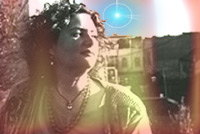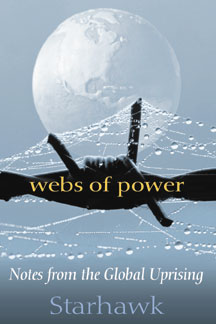|
What We Did When They Voted for War
by Starhawk
|
On Sunday, October 6, we had a big Not In Our Name rally in San
Francisco, with something like 10,000 people in Union Square. When I spoke,
I asked how many people had called, written or emailed their elected
representatives about the war. I think every person in the crowd raised
their hands. I asked how many would consider civil disobedience, and at
least three quarters raised their hands. That gave me ideas!
|
 On Monday night, October 7, we had a meeting at UC Berkeley and came up
with an ambitious plan to respond to a war vote. We would meet at the BART
(our rapid transit) station at Market and Montgomery, near Feinstein¹s
office (our one Senator who was possibly going to vote for the war.) We¹d
march to the Federal Building, encamp there for the night (it was an
unusually warm night when we planned this action) and blockade it in the
morning.
After three days of frantic organizing, we met on the day the House
voted for war, Thursday, October 10. We gathered for the march, and after a
slow beginning, more and more people began to arrive. Art and Revolution
brought signs and beautiful banners, and close to a thousand of us marched
down Market Street, chanting,
On Monday night, October 7, we had a meeting at UC Berkeley and came up
with an ambitious plan to respond to a war vote. We would meet at the BART
(our rapid transit) station at Market and Montgomery, near Feinstein¹s
office (our one Senator who was possibly going to vote for the war.) We¹d
march to the Federal Building, encamp there for the night (it was an
unusually warm night when we planned this action) and blockade it in the
morning.
After three days of frantic organizing, we met on the day the House
voted for war, Thursday, October 10. We gathered for the march, and after a
slow beginning, more and more people began to arrive. Art and Revolution
brought signs and beautiful banners, and close to a thousand of us marched
down Market Street, chanting,
- "We don't want to bomb Iraq,
We want to take this country back!" and
"We don't want your oil war,
Peace is what we¹re calling for!" and other favorites, like the
perennial
"Hey hey, ho ho, Bush's war has got to go!"
We came to the Federal Building, took over the plaza in front, which has
recently been remodeled into a strangely inhuman concrete wasteland that
looks as if it were designed for alien mating rites. Actually I believe it
is planned to thwart terrorists from driving trucks full of fertilizer into
the building, and luckily none of us were trying to do that. Instead we had
a number of speeches, then songs, poems, and spoken word performances. The
Brass Liberation Orchestra arrived and played dance music. We sent out for
pizza for a couple of hundred people. Food Not Bombs arrived before the
pizza, but after the meal we held a nonviolent direct action training for
close to a hundred people. By then it was dark, and the line of police in
front of the doors was so close I was tempted to recruit them for a role
play.
A delegation from the Longshore Workers Union arrived, and spoke to us
about their strike and their struggle. A group of us went aside and began
organizing the next day's blockade, forming affinity groups, recruiting
runners and scouts and communications people. Others went back to playing
music and holding discussions. People set up tents on the concrete or threw
down sleeping bags. The warm weather was gone, and the night was cold, but
dry. Around three in the morning, I snuggled up to some of the Not In Our
Name activists and tried to sleep. Around four A.M, the big bass drum
mercifully took a rest and was replaced by a sitar player offering us a
soothing raga.
We woke up early, around five thirty, and began assembling the blockade.
The Federal Building has two main entrances and two driveways into the
parking area below, distributed among the four sides of the building. As
more and more people arrived, it became clear that we actually had enough
affinity groups to effectively blockade all the entrances. A group
duct-taped themselves together in front of the main driveway. A Buddhist
group arrived and began sitting in silent meditation in the front
entranceway. Around the back, the police began arresting protestors who
were sitting in front of the barricades. Some workers were angry, accosting
the lines and attempting to bash protestors with briefcases. More were
supportive, or at least philosophical about not getting to work on time.
The brass band circled the building, providing a lively soundtrack.
Some of the arrests looked rough, but no one was seriously hurt. As
Federal Workers attempted to climb over the barricades, protestors moved in
to block them, and some of the workers tried to climb over the protestors.
We kept the building effectively closed for around three hours. Then, just
before 10 AM, arrests had thinned our numbers, and more and more workers
were getting in. We decided to declare victory, rallied in the plaza, and a
group of us marched back along Market Street to Feinstein¹s office. By
then, the Senate had also voted for war, and we knew that she had voted
"yes", in spite of major opposition by her constituents. The day before,
her aide had informed us that she was getting six hundred calls a day,
running sixty to one against the war.
At the building that houses Feinstein's office, a group of protestors
made a quick, successful end run around the police who were frantically
holding the doors shut, got into the lobby, and took it over. They were
eventually persuaded to leave by a promise that Feinstein's aide would come
down and talk to us. This proved to be a blatant lie, but a small
delegation was allowed up to talk to the aide, a somewhat fruitless effort.
One older man was arrested for no reason anyone could discern‹presumably for
being in the wrong place at the wrong time.
Almost all the Federal Building protestors were cited and released. Two
were charged with misdemeanor assault‹one because she was pushed by a
plainclothes cop into a line of police, and one, again, for no reason anyone
can quite fathom because she was arrested before any Federal workers
attempted to cross her line. Nevertheless, some employee from the Federal
prosecutor¹s office had her charged with assault. A number of us managed to
arm twist the Federal Marshalls into allowing us into the arraignment‹which
we as the public had a right to attend. Then I went home for a much
deserved nap.
All in all, it was an amazing, empowering action, especially given the
short time we had to organize it. Most of the people who blockaded had
never done civil disobedience before. Now the challenge is to build on
this, and channel the discontent and urgency so many people feel into
effective action.
– Starhawk
From the Rad-Green mailing list
Latest book:
 Webs of Power is a call to reconceive our political and economic systems at the very deepest levels. Writing from the front lines, Starhawk chronicles the global justice movement sparked by Seattle's 1999 anti-World Trade Organization protest. An activist in many of the major peace and justice movements of our times, Starhawk is deeply involved as a direct action participant and trainer in the anti-globalization movement.
The book is divided into "Actions" and "Visions." In Part I, Starhawk begins with a direct-action perspective of what really happened in Seattle and provides an overview of the complex political and economic powers that the anti-globalization movement opposes. Recounting the blow-by-blow events of the critical confrontations faced by the anti-globalization protestors after Seattle, Prague, Brazil, Quebec, Genoa, Starhawk discusses police brutality, the Black Bloc versus the pacifists, and the magic of solidarity.
In Part II, Starhawk spins a vision of the future of the anti-globalization movement. Drawing on her twenty years of experience as an activist, ecofeminist, and witch, she explores the debate between violent and nonviolent tactics; the definition of an economy of true abundance; and how we can transform our rage and despair, face our fears, and renew our spirits while acting to change the world.
Webs of Power is a call to reconceive our political and economic systems at the very deepest levels. Writing from the front lines, Starhawk chronicles the global justice movement sparked by Seattle's 1999 anti-World Trade Organization protest. An activist in many of the major peace and justice movements of our times, Starhawk is deeply involved as a direct action participant and trainer in the anti-globalization movement.
The book is divided into "Actions" and "Visions." In Part I, Starhawk begins with a direct-action perspective of what really happened in Seattle and provides an overview of the complex political and economic powers that the anti-globalization movement opposes. Recounting the blow-by-blow events of the critical confrontations faced by the anti-globalization protestors after Seattle, Prague, Brazil, Quebec, Genoa, Starhawk discusses police brutality, the Black Bloc versus the pacifists, and the magic of solidarity.
In Part II, Starhawk spins a vision of the future of the anti-globalization movement. Drawing on her twenty years of experience as an activist, ecofeminist, and witch, she explores the debate between violent and nonviolent tactics; the definition of an economy of true abundance; and how we can transform our rage and despair, face our fears, and renew our spirits while acting to change the world.
|
|